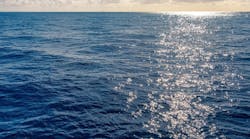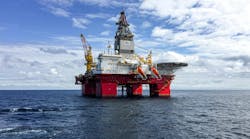Japan, Indonesia, India, others continue second
generation of resource evaluation, recovery
Jin S. Chung
Colorado School of Mines
- A nodule mining system of an 18,000-ft pipe system with elastic joints and axial dampers.
- A Mining equipment graphic
- A Japanese mining system for an at-sea pilot system test.
The deep seabed promises to make an enormous contribution to the world's resource base, once its potential is fully realized. Manganese nodules and cobalt-rich crust are resources of current interest for exploration. These are deposited over and beneath the ocean floor at 800-6,000-meter depths.
Manganese nodules containing attractive quantities of nickel, copper, cobalt, and manganese are distributed in nodular form on the deep-ocean floor at depths of 3,000-6,000 meters. Cobalt-rich manganese crusts are deposited at 800-2,500-m depth in the North Pacific Ocean.
The original R&D was carried out in the '70s by four international consortia ( the companies from the U.S., Canada, Europe, and Japan, some with at-sea pilot system or component tests. No commercial mining system has ever been tested. Research on deep-ocean mining in the US, most active in the 1970s, practically ceased, as Ocean Minerals Co. (OMCO) of California, the consortium of Lockheed, Dutch Shell, Amoco, and Bos Khalis, ceased its active research in 1981. In 1995 OMCO is back to Lockheed after the others withdrew from the consortium, and now basic research is conducted only by academic institutions in the US.
The Law of the Sea treaty became effective in November 1994. Each premier investor has the obligation to prepare legal, environmental, and technological background for future mining operations. Manganese nodule mining usually involves coordination or integration of five distinct systems of operations: (1) an exploration survey, (2) a nodule collection from the seafloor, (3) hoisting to the mining ship, (4) transportation to land, and (5) processing onshore or in the ocean.
Recent Activities
JAPAN. Japan's Ministry of International Trade and Industry (MITI) has promoted the research and development of a nodule mining system with a contract in 1981 with the Technology Research Association of Ocean Mineral Resources Mining System (TRAM). The Metal Mining Agency of Japan (MMAJ) started the exploration for manganese nodules in 1975, and the survey of the cobalt-rich manganese crust in 1987. The Geological Survey of Japan (GSJ) and National Institute of Resources and Environment (NIRE) have been conducting a geological study and fundamental engineering research. The Agency of Industrial Science and Technology (AIST) of MITI started the national R&D program of developing manganese nodule mining technology in 1981. MMAJ started the R&D program of nodule processing technology and the environmental impact of ocean mining in 1989.
The 13-meter-long collector will be towed by a flexible hose, collecting nodules with a waterjet flow, and feeding them into the lift pipe. This phase is almost completed, except for some instrumentation devices. The 15-cm-diameter lift pipe system is also completed, with several 100-meter-long flexible hoses. For the airlift system, two of the three-stage air compressors and air hose are completed. The two eight-stage, deep-submerged pumps and electrical motors have been developed. For the instrumentation and control system, a hybrid, deep-ocean cable has been developed. This cable is composed of power cables for the underwater pump, three conductor cables for the power supply to the instrumentation, and several optical-fiber cables for the instrumentation and control signal. Deep-ocean connectors for the electrical power and optical signal have also been developed. Construction of the onboard handling system and conversion of a ship into a pilot test ship are the final phase before the pilot system test in 1997. However, the at-sea test may be limited to component tests, and the total pilot system test is again to be postponed beyond 1997. Japan is likely to survey nodule and crust deposits in the EEZ of the Republic of Marshall Island in 1996.
INDIA. India has already undertaken more than 2,000 shipdays of extensive survey cruises in the Central Indian Ocean for the exploration of manganese nodules. The exploration task is assigned to the National Institute of Oceanography, Goa. The metal contents of the nodules are: 0.12-0.19 Co, 0.85-1.31 Ni and 0.68-1.39 Cu. India projects a semi-industrialized phase by 1997 with a view to commercial nodule mining by 2010. From the technological point of view, 1997 for the semi-industrialized phase seems overly optimistic.
INDONESIA. Indonesia has been producing tin from offshore and is developing a plan for ocean-resource development. PT Timah, the world's largest producer of tin from the ocean, established the Ocean Engineering Research Center to develop the R&D capability for new mineral production from water deeper than 100 m within Indonesia's EEZ. The Center already initiated automation research of tin dredge operations to lower the production cost.
OTHERS. Intero-ceanmetal (IOM) consists of Bulgaria, Cuba, the Czech Republic, Poland, the Russian Federation, and the Slovak Republic. IOM has been granted the certificate of compliance and is working out a long-term plan, including a pilot mining system up to 2015. Korea's program is coordinated by the Korea Association of Deep-Ocean Mineral Development (KADOM) in Seoul, combining the government initiative with the private sector. More than 30 major private companies participate in KADOM. China has also been surveying its claim area. The program is coordinated by the China Ocean Minerals Research Administration (COMRA), Beijing. Finland worked for a few years with the USSR in developing a nodule mining system in the '80s.
Cobalt-rich crusts
At 4,000-6,000-meter depths, the deposits are usually in the form of nodules on the seafloor. But the cobalt-rich deposits exist in a form of crust on the seafloor at 800 to 2,500-m depths and are distributed in various forms and sizes on the surface above the substrates as well as buried beneath the sediment.
Exploration surveys have been conducted by several countries on cobalt-rich manganese crusts on the seafloor from the early '80s. The U.S has a greater geological emphasis; Japan a greater engineering emphasis. Since 1987, Japan, with its interest in the development of a crust mining system and engineering, has conducted an extensive exploration survey, including the equatorial region of the Central Pacific Ocean around Marcus Island and Okinotori Sima Island. A recent Hakurei-maru No. 2 cruise survey reveals that the cobalt-rich crusts are located not only on the seafloor surface, flat to 20 slope, but also buried beneath the calcareous sediment layer. The thickness of the crust near Marcus Island is generally five to 10 cm and even up to 20 cm. Upon the recent confirmation of the existence of the crust deposits beneath the sediments, the reserve estimate rose three to five times above previous evaluations. The cobalt content of the crust exceeds 1%, three to five times that of the manganese nodules. This may put the crust before the nodules in terms of commercial interest.
Environmental study
The UN requires the premier investors to prepare an environmental study over their claim area. There are three approaches to assess the impact of ocean mining on the environment: (1) assess the dispersion of the discharged water from the mining systems, (2) obtain the baseline data on the physical, chemical and biological environment in and around the claim area, and (3) study impact on the ocean bottom using a disturbing test of seafloor. The U.S. (NOAA) conducted the environment study DOMES in the '70s.
In 1989, Japan started the R&D program of nodule processing technology and the environmental impact of ocean mining, and has been actively conducting the environmental study The US (NOAA) and Japan (MMAJ) have a cooperative program in the environmental study in the Pacific Ocean. Also, the environmental study has been carried out in its claim area, the SE Pacific Peru Basin, by TUSCH (deep-sea environment protection.), Germany. Environmental data including megabenthic activity have been collected by India.
Mining systems
There was no at-sea test of any deep-ocean mining system since the 1970s. In the last 10 years, few significantly new technologies in the nodule mining system appear to have evolved. However, subsystems have been designed and tested systematically in Japan. Some progress has been made in the seafloor miners (or collectors), hoisting systems, and pipe dynamics. In view of deep water depth, all ship or surface systems are dynamically positioned, but not much new ship technology is required.
New researchers tend to prefer a self-propelled seafloor miner, being freed from the motion of the pipe bottom. For such mining systems, it is desirable to explore ways to reduce the lateral deflection and axial motion and stress of a long vertical pipe, while keeping minimal interruption in the vertical slurry transport or lift. For the cobalt-rich manganese crust mining, the miner may be quite different in design from that of manganese nodules.
The mining system and its position control system should be designed to minimize the possibly adverse dynamic influence of the pipe on the miner's track-keeping ability, increasing the nodule recovery sweep efficiency. The miner and collecting equipment must operate on such uneven terrain and obstacles, and the dynamic behavior of the pipe makes the entire mining system-control difficult.
- Pipe Deployment and Retrieval. Especially prior to and during a storm, these are a very important part of a mining operation from the 6,000-meter seafloor. No pipe-handling system is capable of carrying out the pipe deployment and retrieval operation fast enough within current weather forecast capability.
- Nodule Miner (or Collector). For nodule mining, no new miner systems seem to have been developed since the '70s. Two types of seafloor nodule miners are under active consideration: the tow-sled (TS) and the remote-controlled and self-propelled miner (RCM) systems. Japan designed a TS test miner whose sweep efficiency is lower than the RCM system's because of difficulties in TS track-keeping control. At-sea tests of an RCM maneuvering on the seafloor were successfully conducted in the late '70s in the Pacific Ocean, using the dynamically positioned ship Glomar Explorer operated by OMCO. The miner should have a good track-keeping control ability to increase the nodule collection rate per sweep area or the sweep efficiency. The lateral oscillation of the pipe bottom can influence the miner track-keeping control and nodule sweep efficiency.
- Lift to the Ocean Surface. The nodules collected by the miner are in the form of a mixture of nodules, soil particles and water. The buffer is connected at the bottom end of the pipe. It can control the nodule-water mixture ratio. The hydraulic system hoists (or lifts) the nodules in two-phase (nodule-water) flows with pumps to the ship through the miner-to-buffer link, and the vertical pipe. Deep submersible pumps, driven by submerged 1,000-1,700 kW electric motors, were developed in Japan for its at-sea test and are to be installed at 1,000 meters and 2,000 meters below the free surface. With a pneumatic (or air-lift) system, the nodule lift involves three-phase (nodule-water-air) flows. This system is simpler but consumes more power than the hydraulic system. Japan's compressed-air injection point is planned for 1,750 meters. Depth of the air release is important. The pipe system can be used for lifting the crust pieces by means similar to those proposed for the nodule lift. While specific gravity is almost identical for both nodules and crust, the strength is different.
- Lift Pipe. There have been a few important findings for pipe design. Oscillating axial stresses were found to be a critical design parameter for designers of such a deep-ocean pipe. Components of the five-s period, which can be an axial pipe resonance period, are frequently encountered in the ocean, and the ship motion can easily excite axial resonance. Recently, it was found that proper arrangements of multiple elastic joints and axial dampers installed along the pipe with its bottom free can reduce the static bending deflection and the axial stress and bending moments. Another more significant finding relates to pipe torsion. Potential pipe detorquing was a concern during an at-sea test in the Pacific Ocean. Power or data cables are installed along the pipe, some pump systems are installed off-center of the pipe, and the air supply tubes for the airlift run deep alongside the pipe. These asymmetric arrangements induce external flow-induced torsional moment, substantially twisting the pipe, and moreover induce the nonzero lateral force, pushing the pipe in the lateral direction.
Deep-ocean drilling, pipe-laying, survey, tow cable, and deep-ocean scientific research will all benefit from new technologies evolving from deep-ocean mining. The importance of axial pipe stress in design already was recognized in the riser design.
For the next 10 years, the Pacific Rim countries will be most active in R&D, mainly because of their late start. The consortium technologies of the 1970s are aging along with nearly all experts, either retired or retiring in the U.S. By 2010, Japan's design and most of its hardware technology will also be aged. New experts need to be trained. For such situations, one wonders if the technology transfer for deep seabed mining is a real issue.
The participants at the First ISOPE (1995) Ocean Mining Symposium, held in Japan in November 1995 ( representatives from seven countries ( agreed to establish a nongovernmental body, the Ocean Mining Working Group, to promote close international cooperation. The group can also act as an informal channel among governments. It will meet at the Deep-Ocean Technology Symposium, to be held in Los Angeles on May 31-June 1, 1996 and sponsored by the National Science Foundation.
AUTHOR
Jin S. Chung earned his BS and MS degrees in naval architecture from Seoul National University and the University of California at Berkeley and his PhD in applied mechanics from the University of Michigan at Ann Arbor in 1969. He worked with Exxon Production Research Co., Houston, 1969-1973, and as commercial systems and technology team leader of Ocean Mining Program, Lockheed Missiles & Space Co. in Sunnyvale, California, 1973-80. He is now a Professor of Engineering at the Colorado School of Mines in Boulder, Colorado, USA.
Copyright 1996 Offshore. All Rights Reserved.




